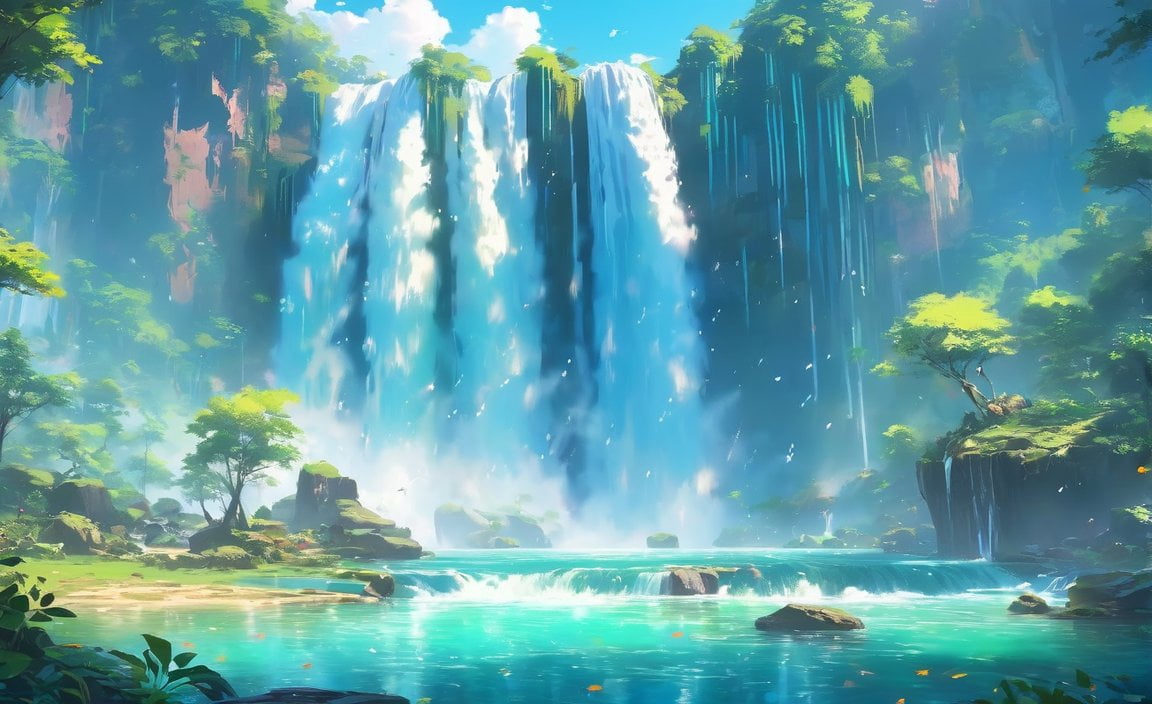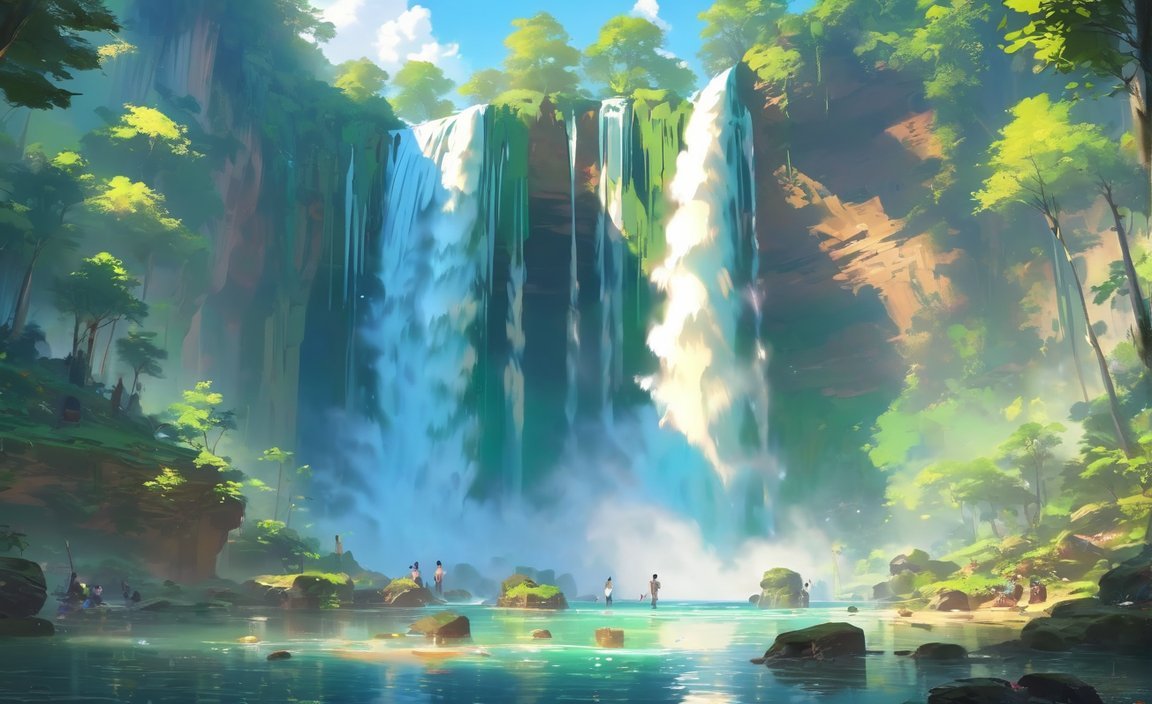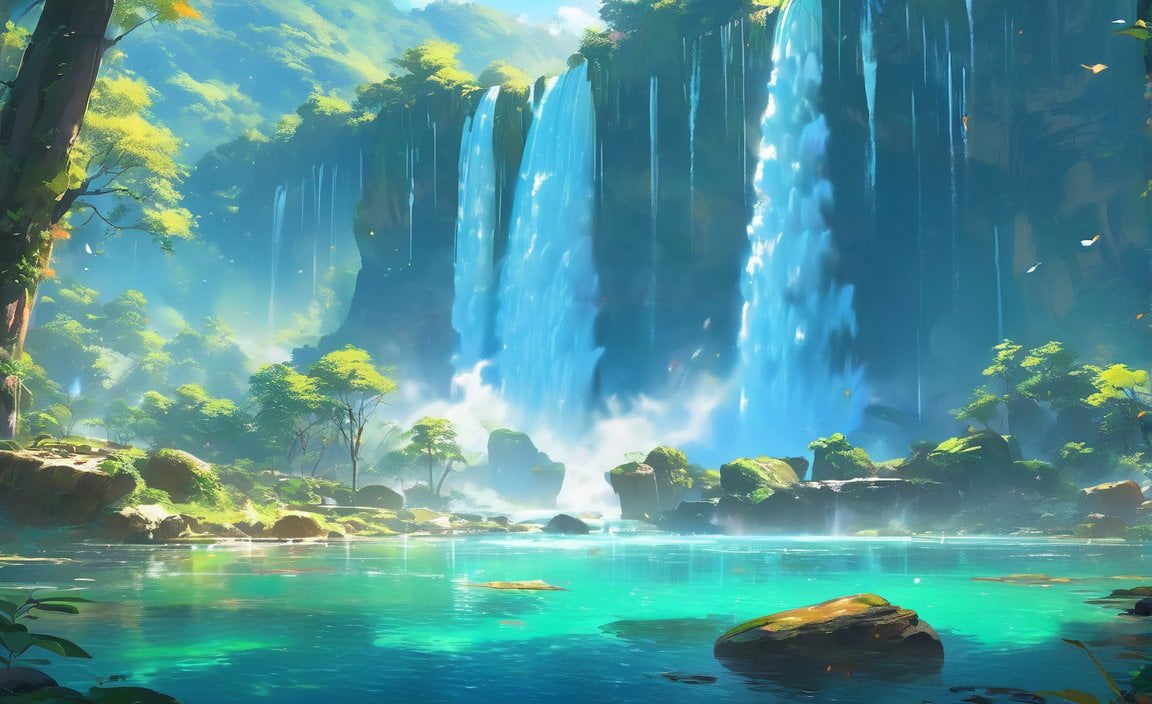Discover the intriguing world of waterfalls with our fascinating collection of 10 facts. As an experienced nature enthusiast and travel writer, I have delved into the mesmerizing realm of cascades, uncovering their geological origins, ecological importance, and cultural significance. Join me on an exploration of these natural marvels as we dive into their unique characteristics, captivating stories, and the awe-inspiring flora and fauna that call them home. Get ready to be enchanted by the mesmerizing beauty of waterfalls and the wonders they hold.
Key Takeaways:
- Waterfalls develop as granite forms cliffs and ledges, contributing to erosion and shaping the landscape.
- The velocity of the stream increases as it approaches a waterfall, leading to enhanced erosion.
- The movement of water at the top of a waterfall can flatten rocks at the edge due to its force.
- Waterfalls are typically found in higher elevations and mountains, where water flows over a vertical drop along a watercourse.
- Various types of waterfalls exist, including plunge, horsetail, and cataract, each with its distinct characteristics.
- Waterfalls are formed through the erosion process, gradually carving out unique geological formations.
- Waterfalls hold ecological importance, contributing to the preservation and diversity of flora and fauna.
- Waterfalls are culturally significant, often being revered and celebrated in various societies and folklore.
- Exploring waterfalls can be an exciting adventure for nature enthusiasts, offering breathtaking views and serene environments.
- To learn more about waterfalls, refer to the provided sources for additional fascinating and educational information.
10 Interesting Facts About Waterfalls

Waterfalls have captivated explorers, nature enthusiasts, and photographers alike with their awe-inspiring beauty and mesmerizing display of nature’s power. These cascading wonders are more than just a visual treat—they have fascinating geologic origins, play a vital role in ecosystems, and hold significance in various cultures around the world. Get ready to discover 10 intriguing facts about waterfalls that will deepen your appreciation for these natural marvels.
1. Waterfalls: Nature’s Erosion Artists
One of the most fascinating aspects of waterfalls is their role in the process of erosion. As water flows over cliffs and ledges, it gradually wears away the surrounding rock, sculpting breathtaking cascades over time. This erosion process not only shapes the appearance of waterfalls but also contributes to the formation of unique landforms in river networks.
2. Power of Velocity
As water nears a waterfall, its velocity increases significantly. This increase in speed amplifies the erosive power of the water, leading to greater erosion of the underlying rock. The forceful impact of the falling water on the rock below wears it away, contributing to the continuous reshaping of the waterfall.
3. The Art of Flattened Rocks
The movement of water at the top of a waterfall can have a remarkable effect on the rocks it encounters. The constant flow and pressure of the water can flatten rocks at the edge, creating fascinating sheets of stone that seem to defy gravity.
4. Waterfalls: High Altitude Wonders
Waterfalls are typically found in higher elevations and mountains, where the rapid descent of rivers and streams creates the perfect conditions for their formation. The combination of steep slopes and abundant water sources results in jaw-dropping cascades that lure adventurers from all around the globe.
5. Diverse Types of Waterfalls
Not all waterfalls are created equal. There are various types of waterfalls, each with its distinct characteristics. Plunge waterfalls, with their vertical drops that plunge straight down into a pool, offer a dramatic spectacle. Horsetail waterfalls maintain contact with the underlying rock throughout their descent, creating veils of cascading water. Cataract waterfalls, on the other hand, are characterized by a series of cascades and rapids spread over a wide area.
6. Waterfalls: Ecological Hotspots
Beyond their scenic beauty, waterfalls also serve as vital ecological hotspots. The constant flow of water and the unique environment around waterfalls provide a habitat for a diverse range of plant and animal species. These biodiverse ecosystems rely on the continuous moisture and nutrient-rich surroundings that waterfalls provide.
7. Cultural Significance
Waterfalls hold cultural significance in many societies around the world. They have been revered as sacred sites and have often been associated with mythical creatures and legends. From the majestic Angel Falls in Venezuela, believed to be the home of a protective spirit, to the spiritual significance attributed to the countless waterfalls in Japanese folklore, these natural wonders have left an indelible mark on human culture.
8. Waterfalls: Haven for Adventure Seekers
For those seeking an adrenaline rush, waterfalls offer a host of exciting activities. From thrilling waterfall rappelling to the exhilarating experience of swimming in natural plunge pools, adventurers can immerse themselves in the raw power of these cascades. They provide the perfect backdrop for unforgettable moments and lifelong memories.
9. Precious Water Resources
Waterfalls are not merely ornamental features of nature; they also play a crucial role in our planet’s water cycle. As water plummets down the cascades, it breaks into smaller droplets, facilitating the aeration and oxygenation of the water. This process enhances the overall quality of the water, benefiting the downstream ecosystems and contributing to the balance of our natural environment.
10. Tales of Endurance
Waterfalls are a testament to nature’s resilience and endurance. Despite the constant forces of gravity and erosion, these cascades endure, captivating generations with their timeless beauty. Their ability to adapt to ever-changing conditions reminds us of the remarkable strength and adaptability of the natural world.
So next time you encounter a waterfall on your travels or in the pages of a book, take a moment to appreciate the fascinating facts behind these incredible wonders. From their geological origins and ecological importance to their cultural significance and enduring beauty, waterfalls are nature’s enchanting masterpieces.
Here are some interesting facts about veterinarians:
- Did you know that veterinarians can treat not only cats and dogs, but also exotic animals? Learn more about these fascinating professionals here.
Explore 10 lines on endangered animals:
- Discover interesting facts about endangered animals and how we can protect them here.
Learn even more about tigers and their status as an endangered species:
- Dive into 10 intriguing facts about endangered animals, with a special focus on tigers here.
Now you can click on the links and uncover these captivating insights!
Biodiversity Around Waterfalls

Waterfall ecosystems are not only captivating in their beauty but also harbor a wealth of biodiversity. These natural wonders provide ideal conditions for various organisms to thrive, making them biodiversity hotspots. Let’s explore the intriguing world of biodiversity around waterfalls.
Unique Habitats: Waterfalls create distinct habitats that support a wide range of species. The constant flow of water, humidity, and availability of sunlight near waterfalls create a diverse ecological niche for plants, insects, and small vertebrates.
Ecosystem Engineers: Waterfalls play a significant role in shaping their surroundings. The erosion process that forms waterfalls shapes the landscape and creates microhabitats such as plunge pools, crevices, and wet rock faces. These features serve as crucial refuge and nesting sites for various organisms.
Biodiversity Hotspots: Studies have shown that waterfalls with more consistent water flow and less seasonal variation tend to have higher biodiversity levels. Factors like stream flow, temperature, and water quality contribute to the unique ecological conditions supporting diverse species.
Size Matters: Waterfalls come in various sizes. The widest known waterfall on Earth is the Khon cascade in Laos, spanning over 10 kilometers. Conversely, Victoria Falls in West Africa astounds with its towering height, plunging from a staggering 1800 meters.
Waterfalls Beyond Land: Waterfalls aren’t confined to terrestrial landscapes. Even on the ocean floor, underwater waterfalls exist, albeit in more challenging environments to study. Currents and geological formations combine to create at least seven known underwater waterfalls.
Diverse Types: Waterfalls exhibit different characteristics and are classified into various types. Cataracts are massive, powerful waterfalls, while multi-step waterfalls consist of a series of equally-sized steps, each with its own plunge pool. Block waterfalls form when a natural cliff or ledge causes the river water to cascade over the edge.
Conserving Vital Habitats: Due to the abundance of water and the unique environmental conditions they create, waterfalls play a vital role in preserving biodiversity. Understanding the factors that influence biodiversity levels in waterfall ecosystems helps us protect and conserve these valuable habitats.
Key Takeaways:
- Waterfalls provide unique habitats that support a wide range of species.
- Waterfalls are biodiversity hotspots, with consistent water flow contributing to higher biodiversity levels.
- The size and types of waterfalls vary, from wide cascades to towering plunges.
- Underwater waterfalls exist, although they are challenging to study.
- Waterfalls shape their surroundings and create refuge and nesting sites for organisms.
- Conserving waterfalls is crucial for safeguarding biodiversity.
Source:
– The Biodiversity Hotspots of Waterfall Ecosystems – Energy5
– Waterfalls and Biodiversity in BC – Department of Geography, The University of British Columbia
Waterfalls as Cultural Landmarks
Waterfalls have captivated people throughout history, not only for their natural beauty but also for their cultural significance. These magnificent wonders of nature have become iconic landmarks in various societies around the world. Let’s explore the intriguing ways in which waterfalls have become cultural symbols.
1. Sacred Sites and Spiritual Significance
Many waterfalls hold deep spiritual and religious meaning for local communities. They are often considered sacred sites and are used for rituals, ceremonies, and prayer. For example, in Costa Rica, the La Fortuna Waterfall is revered by the indigenous Maleku people, who believe it is a dwelling place for spirits.
2. Legends and Mythology
Waterfalls are often steeped in legends and mythology, passed down through generations. They are believed to possess mystical powers and to be inhabited by mythical creatures. These captivating stories add to the allure and intrigue surrounding waterfalls, elevating them to the status of cultural landmarks.
3. Inspiration for Art and Literature
Waterfalls have served as inspiration for artists and writers throughout history. Their beauty and power have been captured in paintings, sculptures, poems, and novels. Artists like Thomas Moran and writers like Lord Byron have immortalized waterfalls in their works, transforming them into cultural symbols.
4. Gathering Places for Communities
Waterfalls have historically served as gathering places for communities, providing a natural setting for social interactions and celebrations. People gather near waterfalls for picnics, festivals, and other communal activities, strengthening the social fabric of their cultures.
5. Tourism and Economic Impact
Waterfalls attract tourists from around the world, bringing economic benefits to local communities. They become iconic landmarks that draw visitors, who contribute to the local economy through tourism-related activities. Waterfalls often support the development of hotels, restaurants, and other businesses, further solidifying their cultural importance.
6. Environmental Education and Conservation
Waterfalls play a crucial role in environmental education and conservation efforts. They serve as focal points for educating visitors about the importance of preserving natural ecosystems and biodiversity. By raising awareness and promoting sustainable practices, waterfalls become cultural symbols of conservation.
7. Symbolism in Artistic Representations
Waterfalls have been depicted in various forms of artistic representation, including paintings, photographs, and sculptures. These artistic interpretations contribute to their cultural significance and help to perpetuate their status as landmarks.
8. Cultural Identity and Heritage
Waterfalls often become symbols of cultural identity and heritage for local communities. They are celebrated as natural treasures that represent the uniqueness and beauty of a particular culture. Waterfalls become an integral part of a community’s sense of place and pride.
9. Inspiration for Traditions and Festivals
Waterfalls inspire traditions and festivals that celebrate their magnificence. For example, the Kachikally Crocodile Pool in Gambia holds an annual ceremony where women pass through the waterfall to ensure fertility and a successful pregnancy. These traditions and festivals showcase the cultural significance of waterfalls.
10. Inspiration for Global Explorers
Waterfalls capture the imagination of adventurers and nature enthusiasts from around the world. They inspire exploration, discovery, and a deeper understanding of diverse cultures and landscapes. Waterfalls have become iconic destinations for travel, attracting visitors who seek to immerse themselves in the cultural richness of these natural landmarks.
Key Takeaways:
– Waterfalls hold deep spiritual and religious significance in many cultures, serving as sacred sites for rituals and ceremonies.
– Legends and mythology contribute to the cultural significance of waterfalls, making them subjects of captivating stories and beliefs.
– Waterfalls inspire art, literature, and other forms of artistic expression, immortalizing their beauty in various artistic representations.
– Waterfalls serve as gathering places for communities, fostering social interactions and cultural celebrations.
– Tourism around waterfalls brings economic benefits to local communities and establishes them as iconic landmarks.
– Waterfalls play a vital role in environmental education and conservation, raising awareness about the importance of preserving natural ecosystems.
– Waterfalls become symbols of cultural identity and heritage, representing the uniqueness and beauty of a particular culture.
– Waterfalls inspire traditions, festivals, and rituals that celebrate their magnificence and cultural significance.
– Waterfalls inspire global explorers, attracting adventurers and nature enthusiasts who seek to immerse themselves in diverse cultures and landscapes.
Sources:
– Facts.net – 10 Intriguing Facts About La Fortuna Waterfall
– We Dream of Travel – Best Waterfalls near Cairns: 17 Waterfalls You HAVE To See
The Role of Waterfalls in Erosion
Waterfalls not only captivate with their beauty and grandeur but also play a crucial role in shaping our planet’s landscapes. Through the process of erosion, these natural wonders contribute to the creation of unique landforms and geological features. Let’s delve into the intriguing role that waterfalls play in erosion and discover some fascinating facts about these captivating marvels.
Waterfalls: Agents of Erosion
Erosion is the gradual wearing away of the earth’s surface, and waterfalls are key players in this process. As rivers and bodies of water flow over rocky ledges, the sheer force of the falling water causes the underlying rock to be eroded. This erosion occurs as the water continuously flows, grinds, and shapes the rocks beneath, ultimately forming the magnificent waterfalls we admire.
The velocity of the water near waterfalls is greater than in other areas of a river, intensifying the erosive power. The constant flow and pressure of water at the waterfall’s summit can flatten rocks at the edge, creating sweeping sheets of stone that add to the visual splendor.
But not all water that falls is considered a waterfall. To be classified as such, the water must drop abruptly and nearly vertically, interrupting the flowing river water. It is this interruption and the erosion it causes that give waterfalls their unique characteristics.
The Formation of Waterfalls and Erosion
Waterfalls develop when softer rock erodes faster, while harder rock, like granite, remains intact, forming cliffs and ledges. Over time, the continuous erosion and cutting action of flowing water carve out deep plunge pools at the base of waterfalls. These pools then contribute to further erosion, enhancing the waterfall’s appearance and shaping the landscape.
Geological faults, such as cracks in the earth’s crust, also play a role in the erosion and formation of waterfall landscapes. These faults create pathways for water to flow and contribute to the shaping of the surrounding terrain.
Categorizing Waterfalls and Noteworthy Examples
Waterfalls can be categorized based on their structure and flow. Plunge waterfalls, horsetail waterfalls, and cataract waterfalls are some of the different types that exist. Each type has its unique characteristics and appearance, adding to the diversity of these natural wonders.
While waterfalls are typically associated with towering land-based cascades like Angel Falls in Venezuela, did you know that the world’s largest waterfall is actually underwater? This underwater behemoth, known as the Khon cascade in Laos, boasts a staggering total width of over 10 kilometers.
Key Takeaways:
- Waterfalls are agents of erosion, shaping the earth’s surface through the continuous flow of water.
- The force and velocity of water near waterfalls contribute to their erosive power.
- Erosion by flowing water creates plunge pools and carves out cliffs and ledges, forming distinct features of waterfalls.
- Geological faults play a role in the erosion and shaping of waterfall landscapes.
- Waterfalls can be categorized based on their structure and flow, adding to their diverse characteristics.
- The underwater Khon cascade in Laos is the widest waterfall on Earth.
- Angel Falls in Venezuela stands as one of the largest land-based waterfalls.
Sources:
– Britannica – Waterfall
– Energy5.com – The Role of Waterfalls in Erosion
FAQ
Q1: What are some interesting facts about waterfalls?
A1: Here are some interesting facts about waterfalls:
1. Waterfalls develop as granite forms cliffs and ledges, contributing to erosion.
2. Waterfalls are locations where water flows over a vertical drop along a watercourse, typically found in higher elevations and mountains.
3. There are different types of waterfalls, including plunge, horsetail, and cataract.
4. Waterfalls can be found not only on land but also on the ocean floor.
5. The widest waterfall on Earth is the Khon cascade in Laos, with a total width exceeding 10 kilometers.
Q2: How do waterfalls contribute to biodiversity?
A2: Waterfall ecosystems are known to be biodiversity hotspots, supporting a wide range of species. The unique conditions created by waterfalls, such as strong seasonal variations in stream flow, make them ideal environments for biodiversity to thrive. Factors like stream flow and seasonal variation contribute to determining the biodiversity levels of waterfall ecosystems.
Q3: Where is La Fortuna Waterfall located and what makes it unique?
A3: La Fortuna Waterfall is located in La Fortuna de San Carlos, Costa Rica. It is surrounded by lush rainforest and is part of the Arenal Volcano National Park. What makes it unique is its mesmerizing beauty and the opportunity for visitors to swim at its base.
Q4: How tall is La Fortuna Waterfall and how can visitors access it?
A4: La Fortuna Waterfall drops from a height of 75 meters (246 feet) into a natural pool below. Visitors can access the waterfall through a hiking trail that takes about 20 minutes to walk.
Q5: Why are waterfalls important in terms of their ecological significance?
A5: Waterfalls play a crucial role in shaping the landscape through the erosion process. Additionally, waterfalls create unique environmental conditions that support rich biodiversity. By understanding the factors that contribute to the biodiversity levels in waterfall ecosystems, we can better protect and conserve these valuable habitats.
- China II Review: Delicious Food & Speedy Service - April 17, 2025
- Understand Virginia’s Flag: History & Debate - April 17, 2025
- Explore Long Island’s Map: Unique Regions & Insights - April 17, 2025
















